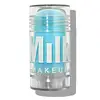What's inside
What's inside
 Key Ingredients
Key Ingredients

No key ingredients
 Benefits
Benefits

 Concerns
Concerns

 Ingredients Side-by-side
Ingredients Side-by-side

Water
Skin ConditioningPropanediol
SolventBis-PEG-18 Methyl Ether Dimethyl Silane
EmollientSodium Stearate
CleansingAloe Barbadensis Leaf Juice
Skin ConditioningKappaphycus Alvarezii Extract
Skin ConditioningMaris Aqua
HumectantCaffeine
Skin ConditioningGlycerin
HumectantStearic Acid
CleansingNylon-12
Sodium Sulfate
Sodium Chloride
MaskingCitric Acid
BufferingPotassium Sorbate
PreservativeSodium Benzoate
MaskingChlorphenesin
AntimicrobialPhenoxyethanol
PreservativeCI 42090
Cosmetic ColorantWater, Propanediol, Bis-PEG-18 Methyl Ether Dimethyl Silane, Sodium Stearate, Aloe Barbadensis Leaf Juice, Kappaphycus Alvarezii Extract, Maris Aqua, Caffeine, Glycerin, Stearic Acid, Nylon-12, Sodium Sulfate, Sodium Chloride, Citric Acid, Potassium Sorbate, Sodium Benzoate, Chlorphenesin, Phenoxyethanol, CI 42090
Water
Skin ConditioningGlycerin
HumectantDimethicone
EmollientPropanediol
SolventDimethicone/PEG-10/15 Crosspolymer
CI 42090
Cosmetic ColorantCaffeine
Skin ConditioningSodium Chloride
MaskingSodium Citrate
BufferingSodium Hyaluronate
HumectantSodium Hydroxide
BufferingPhenoxyethanol
PreservativeP-Anisic Acid
MaskingChondrus Crispus
MaskingDisodium EDTA
Citric Acid
BufferingBiosaccharide Gum-1
HumectantPolymethylsilsesquioxane
Ceramide AP
Skin ConditioningWater, Glycerin, Dimethicone, Propanediol, Dimethicone/PEG-10/15 Crosspolymer, CI 42090, Caffeine, Sodium Chloride, Sodium Citrate, Sodium Hyaluronate, Sodium Hydroxide, Phenoxyethanol, P-Anisic Acid, Chondrus Crispus, Disodium EDTA, Citric Acid, Biosaccharide Gum-1, Polymethylsilsesquioxane, Ceramide AP
Ingredients Explained
These ingredients are found in both products.
Ingredients higher up in an ingredient list are typically present in a larger amount.
Caffeine is most associated with coffee, tea, and cacao. In skincare, it helps with calming inflammation and is rich in antioxidants.
While caffeine is used to treat cellulite and and dark circles, further studies are needed to prove this. It has been believed to help with these skin conditions due to its ability to dilate blood vessels and increase blood flow.
Some studies are looking into caffeine's ability to protect against UV rays.
Learn more about CaffeineCi 42090 is a synthetic dye created from petroleum. It is used to give a bright blue color to cosmetics, medicine, and food.
Citric Acid is an alpha hydroxy acid (AHA) naturally found in citrus fruits like oranges, lemons, and limes.
Like other AHAs, citric acid can exfoliate skin by breaking down the bonds that hold dead skin cells together. This helps reveal smoother and brighter skin underneath.
However, this exfoliating effect only happens at high concentrations (20%) which can be hard to find in cosmetic products.
Due to this, citric acid is usually included in small amounts as a pH adjuster. This helps keep products slightly more acidic and compatible with skin's natural pH.
In skincare formulas, citric acid can:
While it can provide some skin benefits, research shows lactic acid and glycolic acid are generally more effective and less irritating exfoliants.
Most citric acid used in skincare today is made by fermenting sugars (usually from molasses). This synthetic version is identical to the natural citrus form but easier to stabilize and use in formulations.
Read more about some other popular AHA's here:
Learn more about Citric AcidGlycerin is already naturally found in your skin. It helps moisturize and protect your skin.
A study from 2016 found glycerin to be more effective as a humectant than AHAs and hyaluronic acid.
As a humectant, it helps the skin stay hydrated by pulling moisture to your skin. The low molecular weight of glycerin allows it to pull moisture into the deeper layers of your skin.
Hydrated skin improves your skin barrier; Your skin barrier helps protect against irritants and bacteria.
Glycerin has also been found to have antimicrobial and antiviral properties. Due to these properties, glycerin is often used in wound and burn treatments.
In cosmetics, glycerin is usually derived from plants such as soybean or palm. However, it can also be sourced from animals, such as tallow or animal fat.
This ingredient is organic, colorless, odorless, and non-toxic.
Glycerin is the name for this ingredient in American English. British English uses Glycerol/Glycerine.
Learn more about GlycerinPhenoxyethanol is a preservative that has germicide, antimicrobial, and aromatic properties. Studies show that phenoxyethanol can prevent microbial growth. By itself, it has a scent that is similar to that of a rose.
It's often used in formulations along with Caprylyl Glycol to preserve the shelf life of products.
Propanediol is an all-star ingredient. It softens, hydrates, and smooths the skin.
It’s often used to:
Propanediol is not likely to cause sensitivity and considered safe to use. It is derived from corn or petroleum with a clear color and no scent.
Learn more about PropanediolChances are, you eat sodium chloride every day. Sodium Chloride is also known as table salt.
This ingredient has many purposes in skincare: thickener, emulsifier, and exfoliator.
You'll most likely find this ingredient in cleansers where it is used to create a gel-like texture. As an emulsifier, it also prevents ingredients from separating.
There is much debate on whether this ingredient is comedogenic. The short answer - comedogenic ratings don't tell the whole story. Learn more about comegodenic ratings here.
The concensus about this ingredient causing acne seems to be divided. Research is needed to understand if this ingredient does cause acne.
Scrubs may use salt as the primary exfoliating ingredient.
Learn more about Sodium ChlorideWater. It's the most common cosmetic ingredient of all. You'll usually see it at the top of ingredient lists, meaning that it makes up the largest part of the product.
So why is it so popular? Water most often acts as a solvent - this means that it helps dissolve other ingredients into the formulation.
You'll also recognize water as that liquid we all need to stay alive. If you see this, drink a glass of water. Stay hydrated!
Learn more about Water